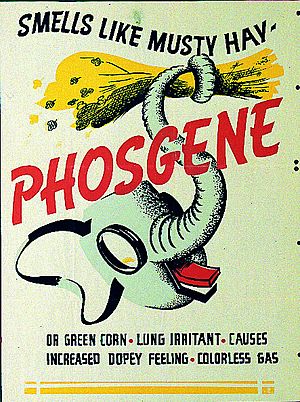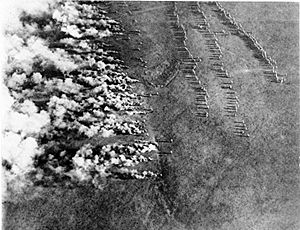Choking agent facts for kids
A choking agent is a dangerous type of chemical weapon. It is also known as a pulmonary agent. These chemicals cause fluid to build up inside a person's lungs. This can make it very hard to breathe and can lead to suffocation. The most common choking agents are chlorine and phosgene.
Contents
What are Choking Agents?
Choking agents are chemicals that harm your lungs. They stop your lungs from working properly. This can make it feel like you are drowning, even though you are not in water. The main goal of these weapons is to make people unable to breathe.
Phosgene Gas

Phosgene is a very dangerous choking agent. It can be a liquid or a gas. As a gas, it is heavier than air. This means it stays close to the ground. People can easily breathe it in for a long time. Phosgene gas smells a bit like freshly cut grass or moldy hay.
Phosgene is also a type of blood agent. This means it stops oxygen from getting into your body's cells. Without oxygen, cells die, and a person can suffocate. The worst effects of phosgene usually do not show up right away. Serious symptoms might not appear until 12 hours after breathing it in. Sadly, people often die within 24 to 48 hours.
Chlorine Gas
Chlorine is naturally a gas. However, it can be changed into a liquid or a solid. Chlorine is used to make many things, like plastics. It is also used to clean swimming pools.
Chlorine gas is very harmful if you breathe it in. It can react with water in your lungs. This reaction creates hydrochloric acid. This is a very strong acid that can severely burn the lungs. Such burns can be deadly.
Signs of Exposure
The signs and symptoms of being exposed to a choking agent depend on how the chemical entered the body.
If a choking agent touches your eyes or skin, it can cause very bad burns.
If a choking agent is breathed in, it usually causes:
If a person breathes in a lot of the choking agent, they will eventually suffocate.
Choking Agents in World War I
Both phosgene and chlorine gas were used as weapons during World War I. Chlorine was used first. It was the first chemical weapon used in the war to try and kill enemy soldiers. Before this, countries like France and Germany had used tear gas, which is not meant to kill people.
Chlorine Gas Attacks
The German Army first used chlorine as a weapon around January 1915. They used it against the British Army. A German officer wrote that their chlorine was "very effective." He said 140 English officers were killed. He called it a "horrible weapon."
About four months later, the German Army used chlorine gas against French and Algerian soldiers. These soldiers did not know about this new weapon. They panicked and tried to run away. But running makes chlorine's effects worse. In just a few minutes, the gas killed over 1,000 French and Algerian soldiers. It injured more than 4,000 others.
One soldier who survived described seeing "figures running wildly." He saw "Greenish-gray clouds" that turned yellow. They "blasted everything they touched." Then, French soldiers came, "blinded, coughing, chests heaving." They had "faces an ugly purple color." He learned that "hundreds of dead and dying comrades" were left behind.
In September 1915, the British Army used chlorine gas as a weapon for the first time. The German Army used chlorine gas many more times. They used it against French, Canadian, and Russian soldiers. In one attack in Poland, 9,000 Russian soldiers were injured by the gas. More than 1,000 were killed.
However, soldiers soon learned how to protect themselves. If they stayed still and got as high off the ground as possible, the effects were less bad. Also, using a damp cloth over their mouths and faces helped. Because chlorine gas is green, soldiers could see it coming. This gave them time to protect themselves. This made chlorine gas less deadly. Both sides soon started using phosgene instead.
Phosgene Gas Attacks
The German Army first used phosgene against the British Army in 1915. After that, phosgene was used often during World War I. Countries on both sides of the war used it. This included Germany, France, the United Kingdom, and the United States. They used phosgene to attack enemy soldiers. Often, they mixed it with chlorine to try and kill more people.
In World War I, about 100,000 deaths were caused by poison gas. Phosgene caused about 85% of these deaths, which is around 85,000 lives lost.
Use After World War I
After people saw how terrible poison gases were in World War I, these gases were not used as often.
However, the Imperial Japanese Army used phosgene against China many times. This happened during the Second Sino-Japanese War (1937-1945).
In 2007, Iraqi insurgents used chlorine bombs. They attacked soldiers and civilians. Over 350 people got sick from the first attack. In two other attacks, more than 30 people died in each attack.
Related pages
Images for kids
See also
 In Spanish: Agente pulmonar para niños
In Spanish: Agente pulmonar para niños



